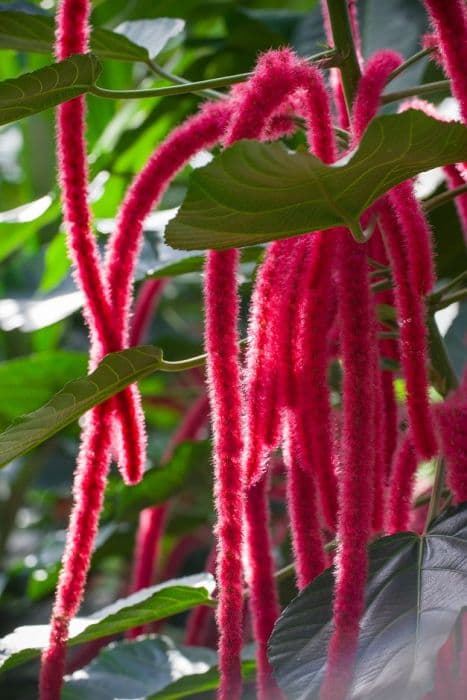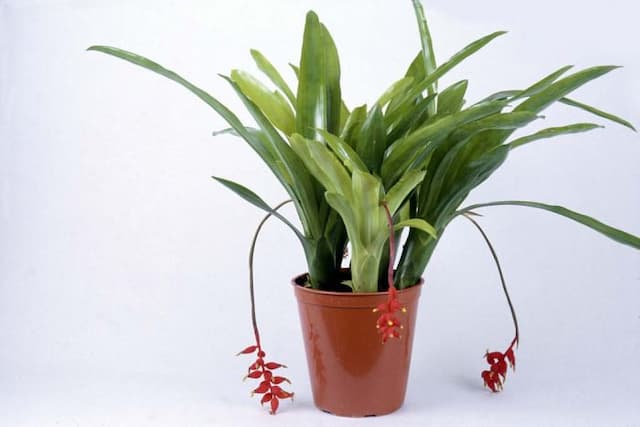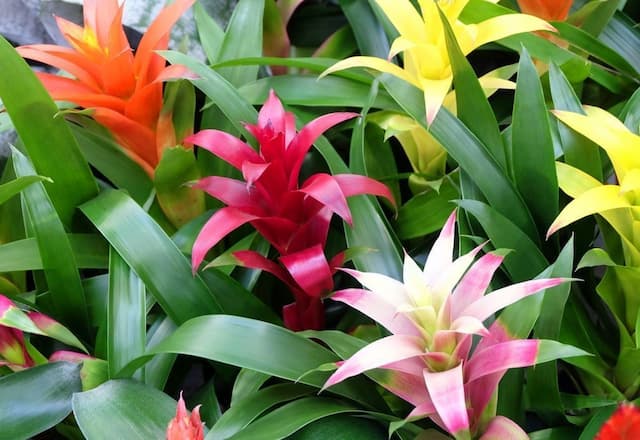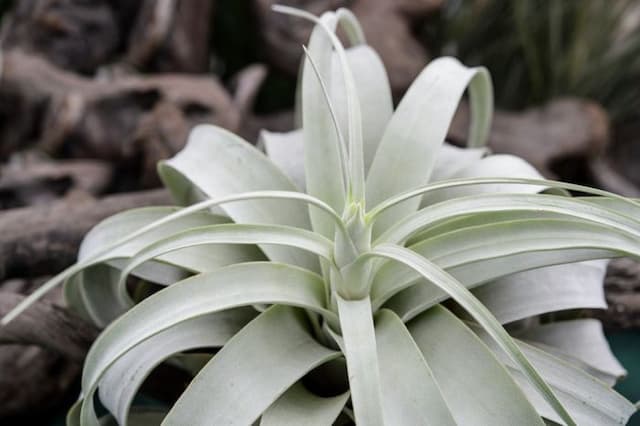Air plant Tillandsia aeranthos
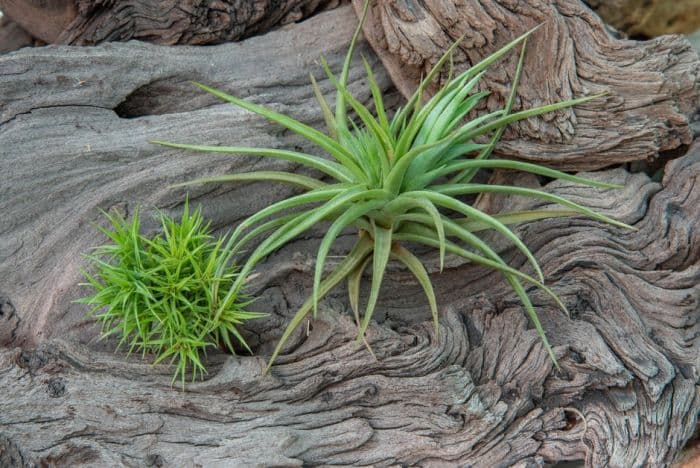
ABOUT
The plant known commonly as the Air Plant has a distinctive form with spiky, thin leaves that grow in a rosette pattern. These leaves have a silvery-green hue, feeling somewhat rough to the touch due to tiny scales on their surface which help the plant absorb moisture from the air. During blooming season, the Air Plant produces vibrant, long-lasting flowers that can be purple, pink, or blue, often complemented by brightly colored bracts that may appear in hues such as red or pink. This plant does not require soil to grow, as it is adapted to cling to various surfaces such as tree branches or rocks. It's a fascinating specimen due to its ability to thrive on air and minimal water, making it unique in the plant world.
About this plant
 Names
NamesFamily
Bromeliaceae
Synonyms
Beret Moss, Air Plant
Common names
Tillandsia dianthoidea, Tillandsia bicolor, Tillandsia unca, Tillandsia microxiphion, Tillandsia pulchella, Anoplophytum unca, Tillandsia aeranthos var. alba, Tillandsia aeranthos var. rosea, Tillandsia pucara.
 Toxicity
ToxicityTo humans
Tillandsia aeranthos, commonly known as air plant, is not known to be toxic to humans. Therefore, there are no symptoms of poisoning or toxic consequences associated with ingesting this plant. However, as with any non-food item, eating plants that are not meant for consumption is generally not advisable.
To pets
The air plant is also not considered toxic to pets. It should not cause any symptoms of poisoning if ingested by animals such as cats or dogs. Nonetheless, it's always best to prevent pets from chewing on any plants to avoid potential choking hazards or digestive issues that can occur from ingesting non-food items.
 Characteristics
CharacteristicsLife cycle
Perennials
Foliage type
Evergreen
Color of leaves
Green
Flower color
Purple
Height
6-8 inches (15-20 cm)
Spread
6-8 inches (15-20 cm)
Plant type
Herb
Hardiness zones
9
Native area
South America
Benefits
 General Benefits
General Benefits- Easy Care: Tillandsia aeranthos, commonly known as Air Plant, requires minimal maintenance, making it ideal for those with a busy lifestyle or new to plant care.
- No Soil Needed: This plant thrives without soil, absorbing moisture and nutrients through its leaves, which allows for creative display options.
- Versatile Display: Air Plant can be placed in a variety of settings such as mounted on walls, placed in terrariums, or simply resting on decorative surfaces.
- Aesthetic Appeal: With its striking grass-like foliage and vibrant blooms, Tillandsia aeranthos adds a pop of color and visual interest to any space.
- Non-Toxic: This plant is safe to keep around pets and children, as it is non-toxic if accidentally ingested.
- Long Blooming Period: It typically has a lengthy blooming period, providing long-lasting beauty throughout the season.
- Propagation Ease: Air plant offsets, or 'pups', can be easily propagated to grow new plants, making it a gift that keeps on giving.
 Medical Properties
Medical PropertiesThis plant is not used for medical purposes.
 Air-purifying Qualities
Air-purifying QualitiesThis plant is not specifically known for air purifying qualities.
 Other Uses
Other Uses- Tillandsia aeranthos, commonly known as Air Plant, can be used in jewelry making, with small specimens being incorporated into pendants or earrings due to their petite size and relatively light weight.
- These plants can be attached to greeting cards or invitations as a unique, eco-friendly embellishment that can be later planted or kept as a memento.
- Crafted into living sculptures, artists utilize the flexible nature and variety of forms of Air Plant to create biological art that evolves over time as the plant grows.
- Tillandsia aeranthos can serve as natural Christmas ornaments, providing a living alternative to traditional decorations that can be enjoyed year-round.
- They are used in educational settings to teach about epiphytism and air plant care, showcasing their unique adaptations to students and plant enthusiasts.
- As components in terrariums, Tillandsia aeranthos adds texture and variety to miniature landscapes without the need for soil.
- These plants can be a means of biological monitoring, as their health may reflect the quality of the air and environment in which they are kept.
- They can be used as natural hair accessories for special occasions, such as weddings or proms, when attached to hairpins or combs.
- In photography, Air Plants are often used as subjects or accessories in macro and still life photography due to their intricate form and texture.
- Used in feng shui, Tillandsia aeranthos is believed to attract positive energy and help with the balance of the indoor environment, enhancing the aesthetics of a living space.
Interesting Facts
 Feng Shui
Feng ShuiThe Air Plant is not used in Feng Shui practice.
 Zodiac Sign Compitability
Zodiac Sign CompitabilityThe Air Plant is not used in astrology practice.
 Plant Symbolism
Plant Symbolism- Independence: The Air Plant can absorb moisture and nutrients directly from the air, symbolizing self-reliance and autonomy.
- Resilience: With its ability to grow in a variety of environments without soil, this plant represents tenacity and adaptability.
- Freedom: Its soil-less nature and ability to drift with the wind until they find a perch could be viewed as a symbol of a free spirit.
- Creativity: The unique and artistic appearance of the Air Plant, with its twisting leaves, signifies creativity and unconventional beauty.
 Water
WaterTillandsia aeranthos, commonly known as Air Plants, should be watered once or twice a week by misting thoroughly until water runs off the plant. During hot and dry periods, you can increase watering to three times a week, but allow the plant to dry out between waterings to prevent rot. If you're soaking the plant, submerge it in water for about 15-30 minutes every one to two weeks, using roughly one gallon of water for multiple plants. Always shake off excess water after soaking to ensure the center of the plant isn't holding moisture, which could lead to decay.
 Light
LightAir Plants prefer bright, indirect light. A spot near an east or west-facing window where they receive a few hours of gentle morning or late afternoon sun is ideal. Avoid placing your Air Plant in direct sunlight, especially during the peak midday hours, as this can cause the plant to dry out rapidly or burn.
 Temperature
TemperatureAir Plants thrive in a temperature range of 50 to 90 degrees Fahrenheit (10 to 32 degrees Celsius), with an ideal climate between 70 and 80 degrees Fahrenheit. They can endure brief periods of colder weather down to 35 degrees Fahrenheit and hotter conditions up to 95 degrees Fahrenheit, but prolonged exposure outside their comfort range can be harmful.
 Pruning
PruningPruning of Air Plants is primarily to remove any dead or damaged leaves and can be done as needed throughout the year. Use sharp, sterilized scissors to cut off the dead or brown tips, preserving the plant's shape. Pruning just after watering when the leaves are more flexible may help avoid accidental damage to healthy parts.
 Cleaning
CleaningAs needed
 Soil
SoilAir plants like Tillandsia aeranthos (commonly known as Air Plant) do not require soil as they absorb moisture and nutrients through their leaves. Instead of soil, they need a mounting surface and air circulation.
 Repotting
RepottingAir Plants do not need repotting as they are not planted in soil. Instead, they may be moved to a larger mount as they grow or if they outgrow their current space.
 Humidity & Misting
Humidity & MistingAir Plants thrive best in humidity levels of 50% to 70%, but they are adaptable and can tolerate a range of humidity conditions as long as they receive regular water misting.
 Suitable locations
Suitable locationsIndoor
Place in bright, indirect sunlight and mist weekly.
Outdoor
Hang or mount in partial shade, shelter from rain.
Hardiness zone
9-11 USDA
 Life cycle
Life cycleThe life of Tillandsia aeranthos, commonly known as the Air Plant, begins with seed dispersion, typically by wind, due to its small and lightweight seeds. After landing in a suitable location, commonly on tree branches or rocks, the seeds germinate and form a small rosette of leaves, during which time they absorb moisture and nutrients from the air through their specialized leaves. As the plant matures, it develops a central inflorescence that bears vibrant flowers, attracting pollinators for sexual reproduction. After pollination, the plant produces seed capsules that eventually burst open, dispersing the seeds to begin a new generation. Simultaneously, the parent plant will often produce offsets, or "pups," at its base, which are clones that can grow independently once they reach a sufficient size. This ability to reproduce vegetatively allows for a clonal colony to form even before the parent plant reaches the end of its life cycle and dies after flowering and seed production.
 Propogation
PropogationPropogation time
Spring-Early Summer
The most popular method of propagation for Tillandsia aeranthos, commonly known as Air Plant, is through the use of offsets, also known as "pups." These pups typically appear at the base of the mother plant after it has flowered. Once they have reached about one-third of the size of the parent plant, they can be gently twisted or pulled away, ensuring that a portion of the base is intact. After removal, the pups should be placed in a bright, airy spot to allow the wound to heal for a couple of days before mounting them or placing them in their new location. It is important to maintain proper air circulation, indirect sunlight, and regular misting with water to help the new plants thrive. This method is simple and effective, allowing enthusiasts to multiply their collection without the need for seeds or special equipment.
